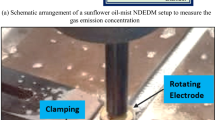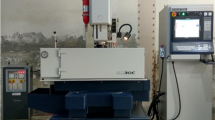Abstract
Electrical discharge machining (EDM) is a nontraditional processing technology that can be used to process materials with a high melting point, high strength, high hardness and low brittleness. Kerosene, as a common dielectric, produces aerosol and toxic gas at high temperatures, which seriously affects the health of operators and air quality. In this study, edible vegetable oils such as sunflower oil, rapeseed oil and peanut oil were used as dielectric to improve the sustainability of EDM. The Taguchi method was used to design experiments, and the effects of vegetable oils with different viscosities on machinability during EDM were discussed from the perspective of mechanism. The machinability was evaluated with the material removal rate (MRR), energy efficiency per unit volume (EEV) and surface roughness (Ra). In addition, the debris diameters of different vegetable oils after processing were studied by using a super depth-of-field optical microscope. The results showed that the MRR of rapeseed oil was 28.9% higher than that of sunflower oil and 25% higher than that of peanut oil. In terms of the MRR, Ra and EEV, rapeseed oil also had obvious advantages because of its high viscosity. In addition, because of the high viscosity of rapeseed oil, the distribution proportion of large fragments was obviously larger than that of the other two oils. The proportion of debris larger than 35 μm in rapeseed oil was 8.21% and that of sunflower oil was only 2.79%. Therefore, vegetable oils can be used instead of a kerosene dielectric to improve the sustainability of EDM and to realize green manufacturing.












Similar content being viewed by others
References
Ho KH, Newman ST (2003) State of the art electrical discharge machining (EDM). Int J Mach Tool Manuf 43(13):1287–1300. https://doi.org/10.1016/S08906955(03)00162-7
Ming WY, Shen F, Zhang Z, Huang H, Du JG, Wu J (2020) A comparative investigation on magnetic field-assisted EDM of magnetic and non-magnetic materials. Int J Adv Manuf Tech 109(3–4):1103–1116. https://doi.org/10.1007/s00170-020-05653-8
Equbal A, Equbal MI, Badruddin IA, Algahtani A (2021) A critical insight into the use of FDM for production of EDM electrode. Alex Eng J 61(5):4057–4066. https://doi.org/10.1016/j.aej.2021.09.033
Niamat M, Sarfraz S, Shehab E, Ismail SO, Khalid QS (2019) Exper- imental characterization of electrical discharge machining of Aluminum 6061 T6 alloy using different dielectrics. Arab J Sci Eng 44:8043–8052. https://doi.org/10.1007/s13369-019-03987-4
Valaki JB, Rathod PP (2016) Investigating feasibility through performance analysis of green dielectrics for sustainable electric discharge machining. Mater Manuf Process 31(4):541–549. https://doi.org/10.1080/10426914.2015.1070430
Tripathy S, Tripathy DK (2017) Surface characterization and multi-response optimization of EDM process parameters using powder mixed dielectric. Mater Today Proc 4(2A):2058–2067. https://doi.org/10.1016/j.matpr.2017.02.051
Khan MY, Rao PS, Pabla BS (2020) Investigations on the feasibility of jatropha curcas oil based biodiesel for sustainable dielectric fluid in EDM process. Mater Today Proc 26(2):335–340. https://doi.org/10.1016/j.matpr.2019.11.325
Nagabhooshanam N, Baskar S, Anitha K, Arumugam S (2021) Sustainable machining of hastelloy in edm using nanoparticle-infused biodegradable dielectric fluid. Arab J Sci Eng 46:11759–11770. https://doi.org/10.1007/s13369-021-05652-1
Leao FN, Pashby LR (2004) A review on the use of environmentally-friendly dielectric fluids in electrical discharge machining. J Mater Process Tech 149(1–3):341–346
Bommeli B (1983) Study of the harmful emanations resulting from the machin- ing by electroerosion. In: Proceedings of the 7th international symposium on electro machining, pp 469–478
Sivapirakasam SP, Mathew J, Surianarayanan M (2011) Multi-attribute decision making for green electrical discharge machining. Expert Syst Appl 38(7):8370–8374. https://doi.org/10.1016/j.eswa.2011.01.026
Valaki JB, Rathod PP, Sankhavara CD (2016) Investigations on technical feasibility of jatropha curcas oil based bio dielectric fluid for sustain- able electric discharge machining (EDM). J Manuf Process 22:151–160. https://doi.org/10.1016/j.jmapro.2016.03.004
Yadav A, Singh Y, Singh S, Negi P (2021) Sustainability of vegetable oil based bio-diesel as dielectric fluid during EDM process - a review. Mater Today Proc 46(20):11155–11158. https://doi.org/10.1016/j.matpr.2021.01.967
Shah ZH, Tahir QA (2011) Dielectric properties of vegetable oils. J Sci Res 3(3):481–492. https://doi.org/10.3329/jsr.v3i3.7049
Amanullah MD, Islam SM, Chami S, Ienco G (2015) Analyses of electro- chemical characteristics of vegetable oils as an alternative source to mineral oil-based dielectric fluid. In: Proceedings of IEEE international conference on dielectric liquids, pp 365–368, https://doi.org/10.1109/ICDL.2005.1490101
Valaki JB, Rathod PP (2016) Assessment of operational feasibility of waste vegetable oil based bio-dielectric fluid for sustainable electric discharge machining (EDM). Int J Adv Manuf Tech 87:1509–1518. https://doi.org/10.1007/s00170-015-7169-0
Mali SH, Kumar N (2016) Investigating feasibility of waste vegetable oil for sustainable EDM. In: Proceeding of all India manufacturing technology, design and research conference, pp 405–410
Singaravel B, Shekar KC, Reddy GG, Prasad SD (2020) Experimen- tal investigation of vegetable oil as dielectric fluid in electric discharge machining of Ti-6Al-4V. Ain Shams Eng J 11(1):143–147
Abdullahi UU, Bashi SM, Yunus R, Mohibullah, Nurdin HA (2004) The potentials of palm oil as a dielectric fluid. Power and energy conference, pp 224–228. https://doi.org/10.1109/PECON.2004.1461648
Ming WY, Xie ZB, Cao C, Liu M, Zhang F, Yang Y, Zhang SF, Sun PY, Guo XD (2022) Research on edm performance of renewable dielectrics under different electrodes for machining skd11. Crystals 12(2):291. https://doi.org/10.3390/cryst12020291
Singh K, Gianender K, Agarwal AK, Ajit K, Yadav R (2017) Effect of dielectric fluids used on edm performance: a review. Int J Emerg Technol Eng Res (IJETER) 5(10):10–16
Marashi H, Jafarlou DM, Sarhan AD, Hamdi M (2016) State of the art in powder mixed dielectric for EDM applications. Precis Eng 46:11–33. https://doi.org/10.1016/j.precisioneng.2016.05.010
Radu M, Tampu R, Nedeff V, Patriciu O, Schnakovszky C, Herghelegiu E (2020) Experimental investigation of stability of vegetable oils used as dielectric fluids for electrical discharge machining. Processes 8(9):1187. https://doi.org/10.3390/pr8091187
Vijaykumar SJ (2018) Multi-characteristics optimization in EDM of NiTi alloy, NiCu alloy and BeCu alloy using taguchi’s approach and utility concept. Alex Eng J 57(4):2807–2817
Yc L, Yf C, Da W, Hs L (2009) Optimization of machining param- eters in magnetic force assisted EDM based on taguchi method. J Mater Process Tech 209(7):3374–3383. https://doi.org/10.1016/j.jmatprotec.2008.07.052
Ming WY, Zhang Z, Wang SY, Huang H, Zhang YM, Zhang Y, Shen DL (2017) Investigating the energy distribution of workpiece and optimizing process parameters during the EDM of Al6061, Inconel718, and SKD11. Int J Adv Manuf Technol 92:4039–4056. https://doi.org/10.1007/s00170-017-0488-6
Daneshmand S (2013) Influence of machining parameters on electro discharge machining of NiTi shape memory alloys. Int J Electrochem Sc 8(3):3095–3104
Straka U, Haova S (2018) Optimization of material removal rate and tool wear rate of Cu electrode in die-sinking EDM of tool steel. Int J Adv Manuf Tech 97:2647–2654. https://doi.org/10.1007/s00170-018-2150-3
Ming WY, Zhang Z, Wang SY, Huang H, Zhang Y, Zhang YM, Shen DL (2017) A hybrid process model for EDM based on finite-element method and gaussian process regression. Int J Adv Manuf Technol 92:4039–4056
Ming W, Zhang Z, Wang SY, Zhang Y, Shen F, Zhang G (2019) Comparative study of energy efficiency and environmental impact in magnetic field assisted and conventional electrical discharge machining. J Clean Prod 214:12–28. https://doi.org/10.1016/j.jclepro.2018.12.231
Dong H, Liu YH, Li M, Zhou Y, Liu T, Li DG, Sun Q, Ji RJ (2019) Experimental investigation of water-in-oil nanoemulsion in sinking electrical discharge machining. Mater Manuf Process 34(10):1129–1135. https://doi.org/10.1080/10426914.2019.1628266
Konig W, Jorres L (1987) Aqueous solutions of organic compounds as dielectrics for EDM sinking. CIRP Ann Manuf Technol 36(1):1129–1135. https://doi.org/10.1016/S0007-8506(07)62564-5
Dhakar K, Dvivedi A (2016) Experimental investigation on near-dry EDM using glycerin-air mixture as dielectric medium. Mater Today Proc 4(4):5344–5350. https://doi.org/10.1016/j.matpr.2017.05.045
Shabgard MR, Seyedzavvar M, Oliaei SNB (2011) Influence of input parameters on characteristics of EDM process. J Mech Eng 57(9):689–696. https://doi.org/10.5545/sv-jme.2011.035
Kuppan P, Rajadurai A, Narayanan S (2008) Influence of EDM process parameters in deep hole drilling of inconel 718. Int J Adv Manuf Technol 38:74–84. https://doi.org/10.1007/s00170-007-1084-y
Pecas P, Henriques E (2003) Influence of silicon powder-mixed dielectric on conventional electrical discharge machining. Int J Mach Tool Manuf 43(14):1465–1471. https://doi.org/10.1016/S0890-6955(03)00169-X
Jilani ST, Pandey PC (1984) Experimetnal investigations into the perfor- mance of water as dielectric in EDM. Int J Mach Tool Des Res 24(1):31–43. https://doi.org/10.1016/0020-7357(84)90044-1
Basha SM, Dave HK, Patel HV (2021) Kerf analysis and control in dry micro-wire electrical discharge machining. Mater Today Proc 38(5):2102–2109. https://doi.org/10.1007/s00170-014-6764-9
Valaki JB, Rathod PP, Khatri BC, Vaghela JR (2016) Investigations on palm oil based biodielectric fluid for sustainable electric discharge machining. In: Proceedings of international conference on advances in materials and manufacturing (ICAMM-2016)
Singaravel B, Shekar KC, Reddy GG, Prasad SD (2020) Performance analysis of vegetable oil as dielectric fluid in electric discharge machining process of inconel 800. Mater Sci Forum 978:77–83. https://doi.org/10.4028/www.scientific.net/MSF.978.77
Reddy GG, Singaravel B, Shekar KC (2019) Experimental investigation of sunflower oil as dielectric fluid in die sinking electric discharge machining process. Proc Mater Sci Forum 969:715–719. https://doi.org/10.4028/www.scientific.net/MSF.969.715
Ng PS, Kong SA, Yeo SH (2017) Investigation of biodiesel dielectric in sustainable electrical discharge machining. Int J Adv Manuf Tech 90(9):2549–2556. https://doi.org/10.1007/s00170-016-9572-6
Ji CX, Zhai YJ, Zhang TZ, Shen XX, Bai YY, Hong JL (2021) Carbon, energy and water footprints analysis of rapeseed oil production: a case study in china. J Environ Manage 287:112359. https://doi.org/10.1016/j.jenvman.2021.112359
Ming WY, Jia HJ, Zhang HM, Zhang Z, Liu K, Du JG, Shen F, Zhang GJ (2020) A comprehensive review of electric discharge machining of advanced ceramics. Ceram Int 46(14):21813–21838. https://doi.org/10.1016/j.ceramint.2020.05.207
Ma J, Yuan J, Ming WY, He WB, Zhang GJ, Zhang HM, Cao Y, Jiang ZW (2022) Non-traditional processing of carbon nanotubes: a review. Alex Eng J 61(1):597–617. https://doi.org/10.1016/j.aej.2021.06.041
Zhang Z, Zhang Y, Ming WY, Zhang YM, Cao C, Guojun Z (2021) A review on magnetic field assisted electrical discharge machining. J Manuf Process 64:694–722. https://doi.org/10.1016/j.jmapro.2021.01.054
Ming WY, Guo XD, Xu YJ, Zhang, GJ, Jiang ZW, Li YZ, Li XK (2022) Progress in non-traditional machining of amorphous alloys. Ceram Int. https://doi.org/10.1016/j.ceramint.2022.10.349
Zhang Z, Zhang Y, Liu D, Zhang Y, Zhao J, Zhang G (2022) Bubble behavior and its effect on surface integrity in laser-induced plasma micro-machining silicon wafer. J Manuf Sci Eng 144(9):091008. https://doi.org/10.1115/1.4054416
Zhang Z, Qiu W, Zhang, G, Liu D, Wang P (2023) Progress in applications of shockwave induced by short pulsed laser on surface processing. Opt Laser Technol 157:108760. https://doi.org/10.1016/j.optlastec.2022.108760
Acknowledgments
This research is supported by Science and Technology Research Project of Henan Province under Grant No. 222102220011, and Local Innovative and Research Team Project of Guangdong Pearl River Talents Program under Grant No. 2017BT01G167. In addition, this research is also supported by the Key Scientific Research Project for Henan Province Higher School of China under Grant No. 21A460034.
Author information
Authors and Affiliations
Corresponding author
Additional information
Technical Editor: Adriano Fagali de Souza.
Publisher's Note
Springer Nature remains neutral with regard to jurisdictional claims in published maps and institutional affiliations.
Rights and permissions
Springer Nature or its licensor (e.g. a society or other partner) holds exclusive rights to this article under a publishing agreement with the author(s) or other rightsholder(s); author self-archiving of the accepted manuscript version of this article is solely governed by the terms of such publishing agreement and applicable law.
About this article
Cite this article
Ming, W., Cao, C., Xie, Z. et al. Green manufacturing: a comparative study of renewable dielectrics in the EDM process. J Braz. Soc. Mech. Sci. Eng. 44, 580 (2022). https://doi.org/10.1007/s40430-022-03867-3
Received:
Accepted:
Published:
DOI: https://doi.org/10.1007/s40430-022-03867-3




